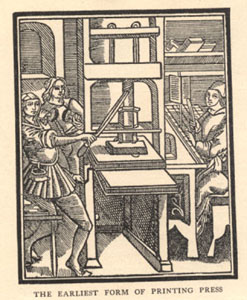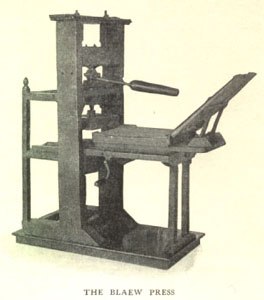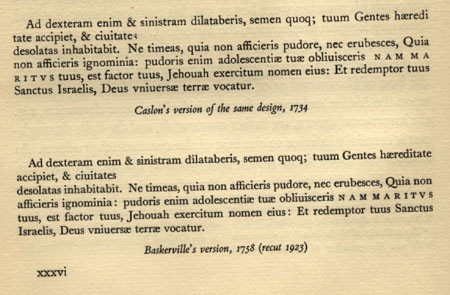Customer: How does the printing process work in the eighteenth century?
Tonson: The printing process itself is not much different than it was in the era of Gutenberg, as printers use the old hand-press device. These presses cost about 15 guineas each, and several are found in any given printing business. Basically, the press works with two main components: a screw and a movable bar. The different blocks of type, which contain the text, are put inside frames called coffins, and those coffins are placed on wood or stone beds and then moved in and out by hand with the lever of the press. Gradually, improvements have been made in the process, though nothing too tremendous, which speaks to the quality of Gutenberg's original design. In the early seventeenth century, the screw was modified by William Jensen Blaew in Amsterdam to make a more equal motion in the pressing, and a rolling bed was also added to make the process easier. After that, hardly any other improvements were made until 1798 when the Earl of Stanhope made a frame out of cast-iron instead of wood, which had been used in centuries previous. In the wake of these small improvements, the printing process itself is still quite simple: make the type from the submitted text, cut the paper and put it under the press, do the actual pressing, and then you have printed text. Of course, the process must be repeated to make those massive quantities of books devoured by the English people in the eighteenth century.13
A printing press from the fifteenth century that is almost identical to the kind of press used in eigtheenth-century England.
The modified printing press developed by William Jensen Blaew in the seventeenth century and the kind used throughout the eighteenth century in England.14
Customer: How does the printing business work in the eighteenth century?
Tonson: Let's take a real example to explain the business of printing. The print shop of William Strahan, Samuel Johnson's chief printer, was a highly important and successful business in the eighteenth century. Strahan's materials included: several presses, 15 by 20 inch and 12 by 16 inch paper (12-20 shillings for a ream of crown sheets), quality ink, several cases of type, and an assortment of locking devices for the printing press. Paper was the most expensive item and was frequently provided by the author or bookseller. As for labor, Strahan's shop employed 50 men in 1759 on a total payroll of 40-50 pounds per week. These workers included a manager with several apprentices and many journeymen, who specialized in some aspect of the printing process. The average rate of work for these men was 250 perfect sheets in two hours, for a weekly payment of 15-17 shillings. Strahan was very careful in calculating his charges to customer. For example, if his wage costs for 1000 sheets of paper came to 14 shillings, he would add 7 shillings for materials, overhead, and profit, and bill 21 shillings total. Strahan was a particularly astute and meticulous business man, and he made a great deal of money for his efforts. One story tells how, while Strahan was printing Johnson's Dictionary in sections, Johnson failed to return several corrected proof pages. Strahan immediately sent a messenger boy to Johnson to complain that the delay was tying up his business and costing him money by the minute, as he could not put in the corrected type from Johnson and get the press working again until Johnson gave him his corrections. Though printing is quite a tedious process at times, when done effectively, printers can get many pages printed and profit immensely.15
Customer: How does the printing business change in the eighteenth century?
Tonson: Volume, volume, and volume. The business has expanded incredibly as a result of the explosion in popularity of print culture. Just take a look at the numbers. In 1725 there were 75 printers in London, but by 1785, there were 124! In 1668, there were 198 men employed in printing, and 3365 men were employed in printing by 1818. These are enormous numerical jumps that prove how significant the growth of printing in the 18th Century really was. Overall, it is estimated that 337,000 book titles were printed in the eighteenth century.16
Customer: What developments are there in the fonts of printing in the eighteenth century?
Tonson: Interesting question, customer. The font, or type, has changed over the years through the work of printers like William Caslon, who infused a Dutch influence into his famous "Old Face" style. The important change over previous types has been in the rounding of letters, which makes for a much easier font to read.17 However, Caslon still maintained some orthodoxies of the older types, such as a narrowness in the spacing. John Baskerville expanded on Caslon's style slightly by creating his own type in printing, which is more open and wider than the traditional style. Baskerville's style actually outlasted Caslon's because it is better suited for smaller print like in newspapers. Still later, John Bell created a French-inspired type that became known as the first modern type. Type style is something that many people overlook in the area of printing, but there are certainly a number of interesting developments in that area.18 Here are some examples of the Caslon, Baskerville, and Bell designs:
Back to Chat Bookbinding Sales and Advertising Booksellers Literacy











